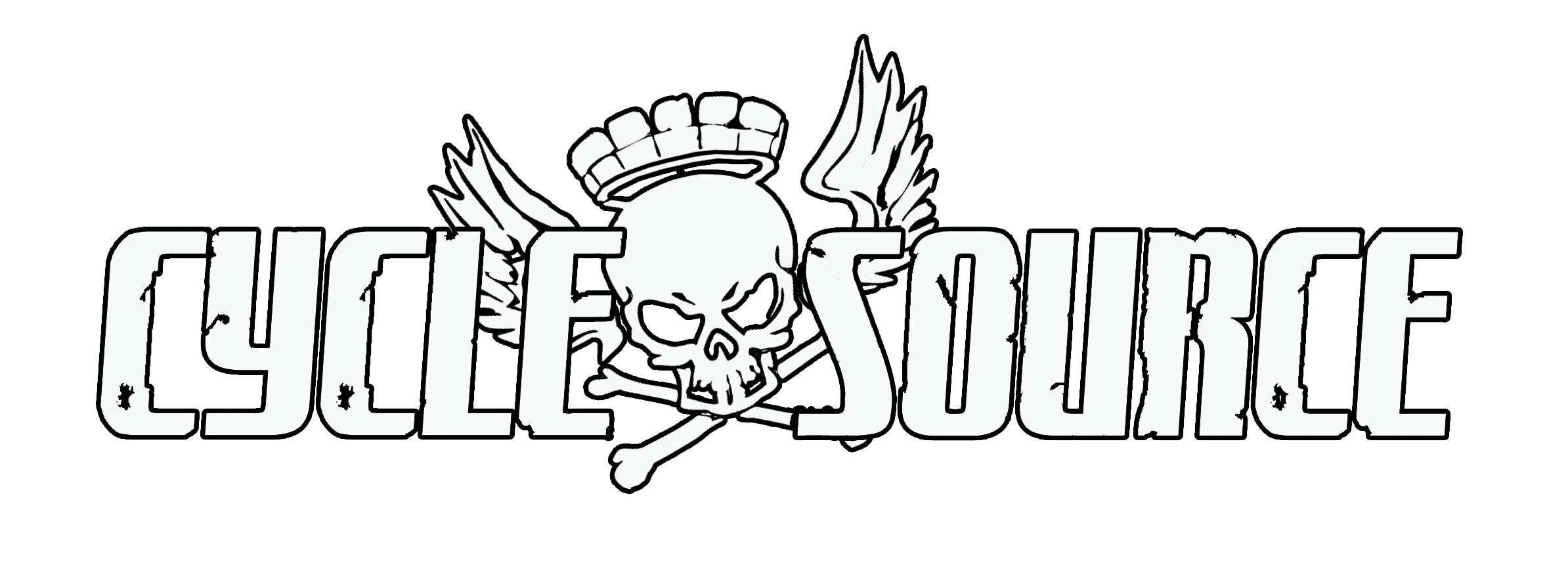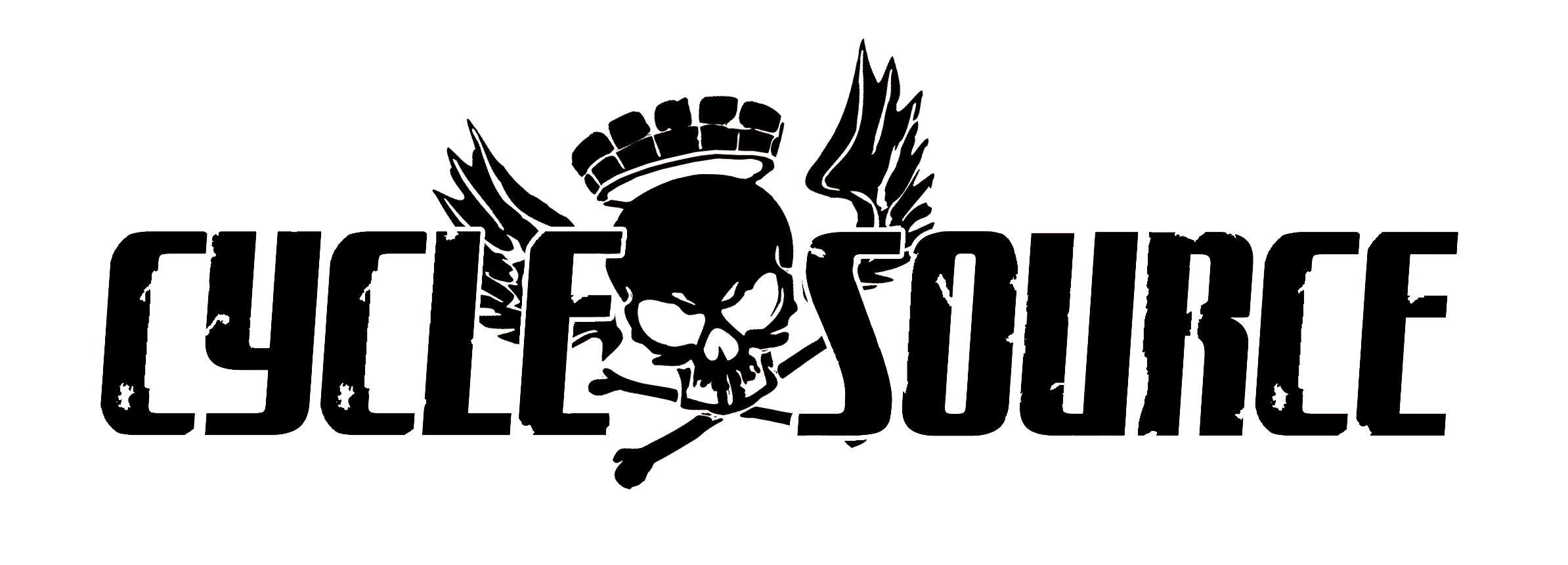Story by Vincent Stemp
Photos by Derek Lloyd
Originally Published In The August 2014 Issue Of Cycle Source Magazine

The girl lived in a trailer park on the northern outskirts of Los Angeles. She was “Trailer Treasure”. It was here that I’d come to stay for the past two weeks. Although this was not the heart of the city, neither could it be confused with countryside. Concrete ruled this place and traffic was often a nightmare. Still, we were a long way from sky scrapers and middle class American homes littered the side streets and cul-de-sacs of this place. She worked by day and often spent time with her grandchildren on weekends, leaving me to comb the city in search of things to do. Car shows, local biker events and rides through the nearby mountains, across Mulholland Drive and through Malibu while on the move along the Coastal Hwy. 1 were common events. Weeks passed.
Black Jack Cycles set on Balboa St was only a few blocks from home, I’d seen the bikes sitting out front, but had yet to stop in. Today was the day. Like most shops, customer bikes were pushed into the parking lot every day to allow room inside for men to work. I pulled in among them. As Betsy’s kickstand hit the ground I noted another old Electra Glide that sat stripped of its sheet-metal and engine. A walk inside led me to the owner. Brent obviously fancied himself a sarcastic comedian and I liked him right off. When the banter and small talk faded I asked about the stripped down FL. “It’s mine,” he said “1993 FLHT. Wrecked it a while back and I’ve been parting it out ever since.”
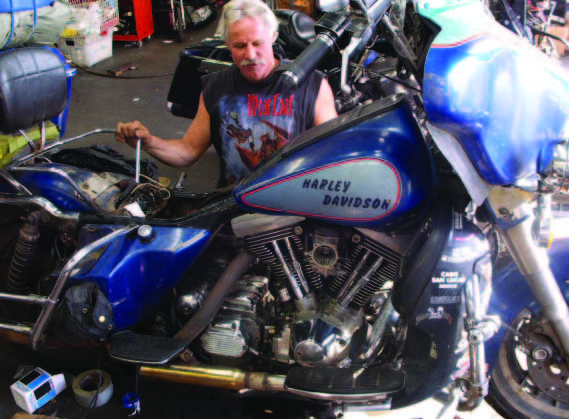
“Think that wiring harness will work in my 1988?” I asked. My wiring was a burned mess of short circuits and electrical tape. A new harness was no longer available. I’d checked. “Harness is a little different, but it’ll work,” Brent said, “The bike’s got 150,000 miles on it though, but everything worked before the wreck. I’ll take $100 bucks for it.” I contemplated. My harness had seen 415,000 K and nothing really worked right. “Can I install it here?” “Sure. Long as you don’t mind working in the parking lot.” The deal was set. I’d start in the morning. Little could anyone guess that this place was to become my daily job for the next month and when the smoke cleared my bike would be dramatically changed and I’d be a far better mechanic.
It was 10:30am and Betsy sat on her center stand in Brent’s lot with seat, tank, saddlebags and fairing removed. I stared with frozen terror at the mass of tangled spaghetti wire. Ted was Brent’s sole mechanic. From inside he’d obviously noted my immobility and wandered out to help—if that’s what you’d call it. With hands moving at breakneck speed he unplugged wire connectors, cut zip ties, yanked the harnesses out of both bikes, threw them on the ground, then went back inside. F@ck. Totally confused and unsure of my ability to ever get these wires working properly, I began to push the harness into place and snap those connectors together that were obviously meant for each other; but there were differences. Where Betsy had the old manual blinker system; the parts bike used an electronic self-canceling box, which was gone. It had cruise control, too. Now I was really lost. Fortunately lunch arrived.
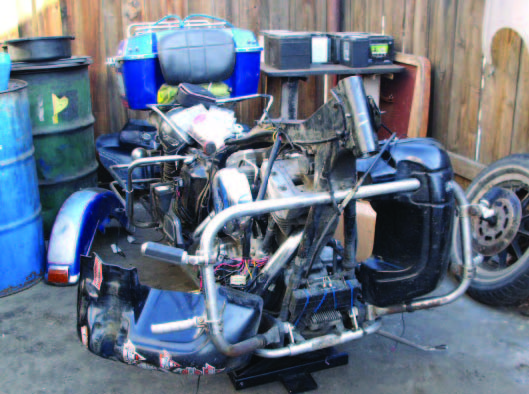
Food had been delivered from a local restaurant and I pulled up an overturned bucket and sat with the others at the lunchtime card table. Although, Lucky drove a truck and rode only a bicycle he came by every day to hang out for hours. From this day forward Lucky, Brent, Ted, and myself would comprise the nucleus of this little Harley shop. The consistently comical Brent was a very picky eater and today he bought my lunch. Brent rode a 100 inch FXR these days. In an hour the job resumed. As I stood looking closely at the fairings of these two bikes the thought came to me that my stereo no longer worked and maybe this one did. I also noted that although busted from the accident, the parts bike’s plastic inner fairing was in far better shape than mine…which was broken from sun exposure and plastic rot.
Eventually Brent wandered out to check my progress. As we gazed at the mass of wires that now hung loose, I spoke of my fear and cluelessness. Brent began pointing to wires and – by only color codeknew where every wire went and exactly what it did. I was amazed. How could anyone know all that about such a tangled mass of spaghetti? He said that wires are just little freeways that take electricity where it needs to go. “These old bikes have no computers. It’s just not that complicated Scotty.” I doubted that. When I asked about the stereo, Brent said it worked and he’d take $75. I bought it. As for the inner fairing Brent replied that it was no good to him broken and I could have it. After Brent went back inside I settled into the task of pulling both stereos and inner fairings. I’ve always been a rather slow, yet extremely persistent, mechanic and the others would poke fun about it for weeks.

Black Jack Cycles was a man’s place filled with motorcycles, tools, parts, camaraderie, friendship and laughter. At day’s end, time was generously allotted for a long bullshit session. When I finally helped push the motorcycles (mine included) back inside, I felt at home and knew these men and I were destined to become good friends. The trailer park was three blocks away so I walked. The shop opened at 9:00am and after pushing bikes back onto the lot, I tore into Betsy. Front end shimmies are almost always caused by worn or loose steering neck bearings. Betsy’s were the originals and to say her front end shimmy was wicked would be a colossal understatement. I’d been ignoring it for years. With the front end already torn so far down it seemed a good time to address the problem. I asked Brent. “Sure,” he said, “Pull it apart. I’ve got new bearings here.”
The bike was moved into a little fenced area beside the shop before being jacked up. I began the process of disassembly. Brent used a torch to help remove the inner bearing races—which made it easy. I installed new ones then re-hung the triple-trees. The forks had never seen a rebuild and with one now held in each hand this seemed like a good time to address that issue as well. Brent said, “Do it. There’s new bushings and seals in the shop.” Again progress dragged. I had no real experience with fork rebuilds and my methodical and unsure movements were anything but quick. But early Harleys are among the simplest motorcycles ever built and most of the job was relatively self-explanatory. Still, the hours moved forward into days as I continued to show up at my new place of employment.

We indulged in long bullshit sessions and I learned more about my companions. Brent was a good wrench before he’d become a factory trained tech. For many years he’d worked for HD, then built choppers for Titan and done time in many other shops as well. Although, I’ve worked among a lot of great HD mechanics, Brent was the best I’d known. Now he was simply burned out. These days Brent spent his time tinkering while Ted performed most of the heavy lifting. For his part, Ted had troubles with the law (weed I think) but seemed to really like this job. Like the guys I’d grown up around, both loved Harleys, knew a lot about them, rode exceptionally well, were exceedingly rough around the edges, quick to laugh, big hearted men who’d do almost anything for a friend. I felt truly at home here.
Both of my fork tubes sported long scratches from dirt and years of hard use. Not wanting to install new rubber seals over scratches, and unable to acquire new tubes, I took a rouge wheel and polished the scratches out. I also noted that one fork tube was slightly bent. Well, so were the handlebars, so I simply installed that tube backwards to tweak the front wheel slightly right and help straighten the handlebars out. It worked. Anticipating the job to come, I’d ordered two tubes of Solerez Extreme from the internet and began to apply generous amounts to the broken inner fairing. This is the only product I’ve used that easily repairs plastic and fiberglass.
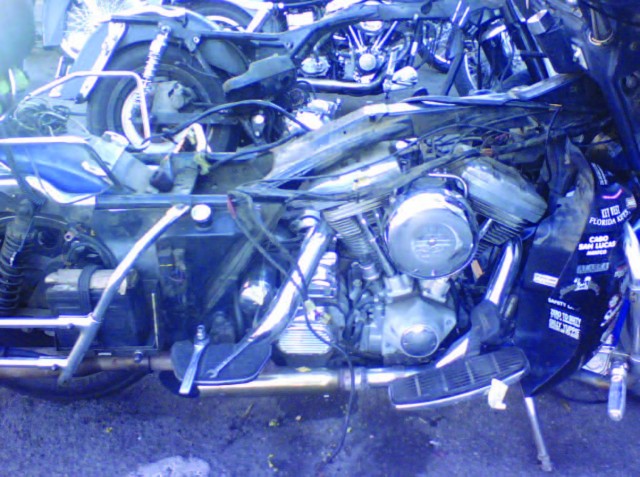
Brent had allowed me to keep the speedo and gauges from the new inner fairing, and when it was mounted I was again faced with the daunting task of hooking up wires. Many of the connectors were identical so I plugged them in. The remainder was not so easy. The parts bike had used an electronic blinker box ($85), while mine took the old manual job. Brent showed me how to make a new blinker wiring harness identical to my old system. Using only three wires and a $6 blinker box from the auto parts store, I found the simplicity of this archaic design amazing. Stock stereos use handlebar mounted controls. The switch used to change radio stations on Betsy’s handlebars was shot and no replacement was available. After installing an inexpensive toggle switch into the fairing, Brent cut two wires from the stereo harness and I ran them to the new toggle. To this day, stations are changed by reaching for that switch.
There were other obstacles, but with Brent’s help all were eventually ironed out. After 1½ weeks work the old FL was again in one piece. To my delight everything (including brake light and blinkers which hadn’t functioned for almost 10 years) worked. At times, I had performed simple repairs on Brent’s customer bikes and, in the end, he charged me a total of $300 for this job. A great deal I’d thought. It felt good to be back in the saddle. For the next week I stopped by the shop often. Brent and I took to riding the mountains together and attending a bike event or two. Talk always turned to shop and I took this opportunity to pick Brent’s brain. For three years I’d been burning through batteries and it seemed like the bike just didn’t have enough electricity to run its systems properly. I was hoping the wiring would solve this problem but it hadn’t. Brent asked if I’d run an AC output test on the stator. Although I knew the test for a bad stator, I’d never heard of this one. A multimeter was produced and it was determined that my charging system’s output was down by 1/3rd. Brent said that the magnets on the rotor had become weak, and that I should replace it with a new stock, or Compufire rotor. The dealership had one for $100. I bought it. Little did I suspect that this simple job would ultimately lead to a complete engine rebuild…
